Hyundai i10 vs Toyota Proace Max – Differences & prices compared
Compare performance, boot space, consumption and price in one view.
Find out now: which car is the better choice for you – Hyundai i10 or Toyota Proace Max?
The Hyundai i10 (Hatchback) comes with a Petrol engine and Manuel or Automatic transmission. In comparison, the Toyota Proace Max (Cargo Van) features a Diesel or Electric engine with Manuel or Automatic transmission.
When it comes to boot capacity, the Hyundai i10 offers 252 L, while the Toyota Proace Max provides – depending on how much space you need. If you’re looking for more power, decide whether the 90 HP of the Hyundai i10 or the 279 HP of the Toyota Proace Max suits your needs better.
In terms of consumption, the values are 4.90 L per 100 km for the Hyundai i10, and 7.80 L for the Toyota Proace Max.
Price-wise, the Hyundai i10 starts at 14600 £, while the Toyota Proace Max is available from 35500 £. Compare all the details and find out which model fits your lifestyle best!
Hyundai i10
The Hyundai i10 impresses with its compact design, making it an ideal choice for navigating through busy urban environments. Its interior is surprisingly spacious, offering drivers and passengers comfort beyond what one might expect from a city car. The model combines efficiency and practicality, making it an attractive option for those seeking both economy and functionality in their daily commute.
details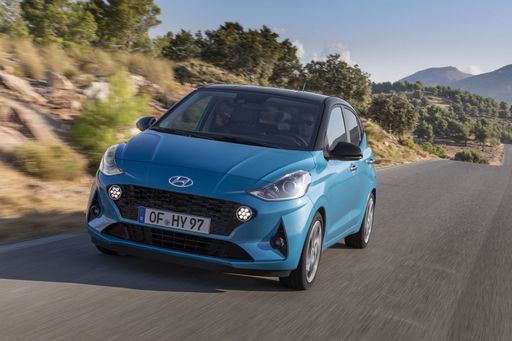 @ hyundai.news
@ hyundai.news
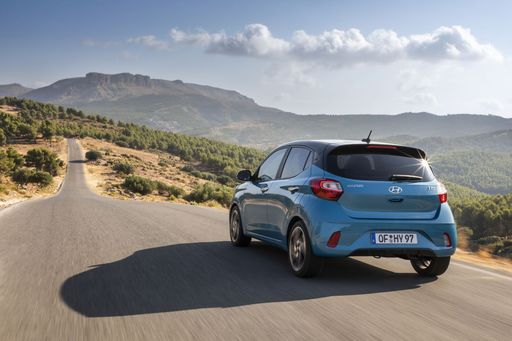 @ hyundai.news
@ hyundai.news
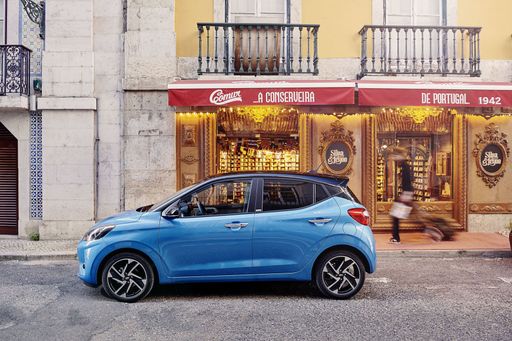 @ hyundai.news
@ hyundai.news
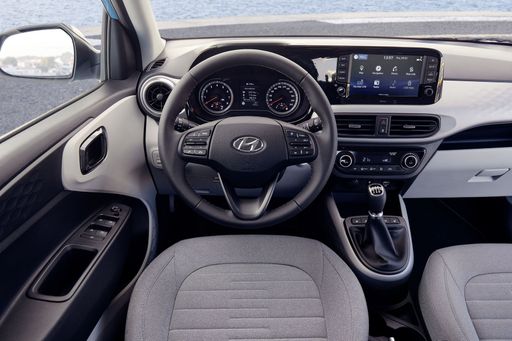 @ hyundai.news
@ hyundai.news
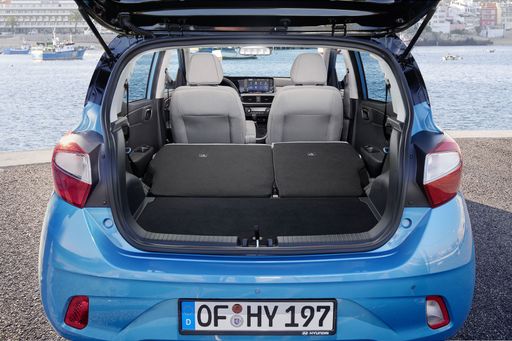 @ hyundai.news
@ hyundai.news
Toyota Proace Max
The Toyota Proace Max is a versatile vehicle that seamlessly combines functionality with style. Its spacious interior is designed to accommodate both passengers and cargo comfortably, making it an ideal choice for families and businesses alike. With a sleek exterior and a range of advanced features, the Proace Max stands out in its class, offering a reliable and efficient driving experience.
details

|
|
|
|
|
Costs and Consumption |
|
|---|---|
|
Price
14600 - 19000 £
|
Price
35500 - 61000 £
|
|
Consumption L/100km
4.9 - 5.5 L
|
Consumption L/100km
7.8 - 8.7 L
|
|
Consumption kWh/100km
-
|
Consumption kWh/100km
-
|
|
Electric Range
-
|
Electric Range
424 km
|
|
Battery Capacity
-
|
Battery Capacity
-
|
|
co2
110 - 124 g/km
|
co2
0 - 229 g/km
|
|
Fuel tank capacity
36 L
|
Fuel tank capacity
90 L
|
Dimensions and Body |
|
|---|---|
|
Body Type
Hatchback
|
Body Type
Cargo Van
|
|
Seats
4 - 5
|
Seats
3 - 7
|
|
Doors
5
|
Doors
4 - 5
|
|
Curb weight
996 - 1099 kg
|
Curb weight
2075 - 2790 kg
|
|
Trunk capacity
252 L
|
Trunk capacity
-
|
|
Length
3670 - 3675 mm
|
Length
5413 - 6363 mm
|
|
Width
1680 mm
|
Width
2050 mm
|
|
Height
1480 - 1483 mm
|
Height
2254 - 2774 mm
|
|
Payload
344 - 423 kg
|
Payload
710 - 1460 kg
|
Engine and Performance |
|
|---|---|
|
Engine Type
Petrol
|
Engine Type
Diesel, Electric
|
|
Transmission
Manuel, Automatic
|
Transmission
Manuel, Automatic
|
|
Transmission Detail
Manual Gearbox, Automated Manual
|
Transmission Detail
Manual Gearbox, Automatic Gearbox
|
|
Drive Type
Front-Wheel Drive
|
Drive Type
Front-Wheel Drive
|
|
Power HP
63 - 90 HP
|
Power HP
120 - 279 HP
|
|
Acceleration 0-100km/h
11.4 - 18.4 s
|
Acceleration 0-100km/h
-
|
|
Max Speed
143 - 175 km/h
|
Max Speed
130 - 161 km/h
|
|
Torque
93 - 172 Nm
|
Torque
320 - 450 Nm
|
|
Number of Cylinders
3 - 4
|
Number of Cylinders
4
|
|
Power kW
46 - 66 kW
|
Power kW
88 - 205 kW
|
|
Engine capacity
998 - 1197 cm3
|
Engine capacity
2184 cm3
|
General |
|
|---|---|
|
Model Year
2024
|
Model Year
2024 - 2025
|
|
CO2 Efficiency Class
C, D
|
CO2 Efficiency Class
G, A
|
|
Brand
Hyundai
|
Brand
Toyota
|
Hyundai i10
Introduction to the Hyundai i10
The Hyundai i10 has consistently proven to be a dependable and stylish companion for urban driving. Known for its compact design and efficiency, this hatchback offers a perfect blend of modern aesthetics and practicality, making it a popular choice for city dwellers and small families alike.
Performance and Efficiency
The Hyundai i10 is available with both manual and automatic transmissions, catering to various driving preferences. Engine power ranges from 63 to 90 PS, providing a versatile driving experience for both novice and seasoned drivers. The fuel consumption varies between an impressive 4.9 to 5.4 litres per 100 kilometres, fitting for those looking to minimise fuel costs while also reducing their carbon footprint.
Engine and Transmission
Equipped with a choice of 1.0-litre or 1.2-litre engines, the i10 offers up to 172 Nm of torque, ensuring lively performance. The models feature front-wheel-drive configurations, allowing for smooth handling and reliable road performance. The car excels in city driving but is equally capable on longer journeys.
Interior and Comfort
Despite its compact size, the Hyundai i10 does not compromise on interior space and comfort. It accommodates four to five occupants comfortably, offering sufficient legroom and headroom. Its flexible seating arrangement and a 252-litre boot make it ideal for both quick trips and weekend getaways.
Safety and Technology
Safety remains a priority with Hyundai, and the i10 is no exception. It comes equipped with multiple airbags, stability control, and advanced braking systems. Technology-wise, the i10 features a user-friendly infotainment system with smartphone connectivity, ensuring a pleasant and connected drive.
Design and Style
The Hyundai i10’s design is both modern and sleek, making it stand out in the compact hatchback segment. With a length ranging from 3670 to 3675 mm, a width of 1680 mm, and a height of 1480 to 1483 mm, the i10 strikes a perfect balance between style and functionality.
Affordable Pricing and Value
The i10 is available in several trims including the Select, N Line, and Prime, among others, with prices ranging from €16,990 to €22,190. Considering its features and low running costs — with monthly expenses estimated between €694 to €793 — the Hyundai i10 offers substantial value for those seeking an economical yet stylish hatchback.
Conclusion
The Hyundai i10 combines efficiency, modern design, and practicality in a compact package. Whether you are seeking a reliable city car or an economical daily driver, the Hyundai i10 is a strong contender worth considering in the compact car market of 2024.
Toyota Proace Max
Introducing the Toyota Proace Max: A Versatile Powerhouse
The Toyota Proace Max is a transport vehicle designed for those who need both muscle and adaptability in their daily operations. As a strong contender in the world of vans, the Proace Max impresses with a range of configurations and specifications tailored to meet commercial needs across different sectors.
Technical Excellence and Versatility
Underneath its robust exterior, the Toyota Proace Max boasts a 2.2-litre diesel engine that provides a commendable range of power outputs from 120 to 180 PS. The versatility of this van is further expanded by the choice between manual and automatic transmissions, ensuring a smooth ride no matter the conditions or preferences of the driver.
With front-wheel drive, the Proace Max delivers reliable traction and handling, even when tackling the tougher terrains. Its carbon dioxide emissions, ranging from 198 to 229 g/km, are a testament to Toyota’s ongoing commitment to balancing performance with environmental responsibility.
Innovative Design and Features
Designed with practicality and functionality in mind, the Proace Max satisfies with a payload capacity of between 1,142 kg and 1,475 kg. This, paired with its generous interior space, makes it ideal for transporting goods, equipment, or personnel.
The van offers several trim levels including Meister, Select, and with an automatic option in Meister and Comfort, all of which provide differing levels of equipment to cater for a wide range of business needs. This ensures that the Proace Max is adaptable, able to transition from a simple workhorse to a more comfortable, feature-rich transport solution with ease.
Fuel Efficiency and Environmental Considerations
The Proace Max manages an impressive fuel consumption rate between 7.5 and 8.7 L/100km, proving economical over longer distances. Its CO2 efficiency class rating of G reflects the necessity for optimum performance balanced with environmental considerations.
This balance of power and efficiency positions the Proace Max as a formidable competitor in its segment, providing a dependable and efficient solution for businesses concerned with both operational costs and environmental impact.
Spacious and Customisable Interior
Inside, the Proace Max accommodates between 2 to 6 seats, depending on the chosen configuration, making it suitable for varying needs whether for transporting crew or cargo. Its dimensions, with a length of up to 6,363 mm and height variants that reach up to 2,764 mm, ensure maximum capacity and flexibility.
For companies that require adaptable transport solutions, the Proace Max allows for significant customisation potential, ensuring the vehicle can be tailored to suit precise requirements.
Conclusion: The Ideal Workhorse
Priced between €41,472 and €64,629, the Toyota Proace Max ensures businesses can invest in a robust, innovative, and flexible transport solution without compromising on capability or efficiency. Designed to meet the demands of various commercial tasks, the Proace Max solidifies its position in the market with its innovative features, versatility, and outstanding performance.
The prices and data displayed are estimates based on German list prices and may vary by country. This information is not legally binding.
